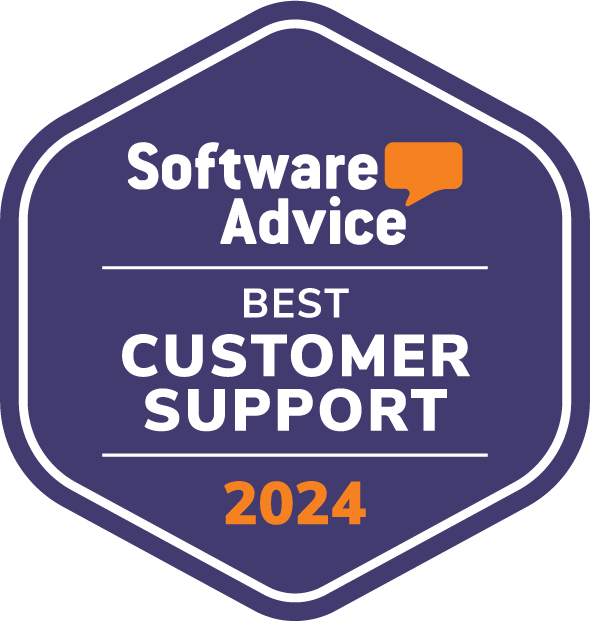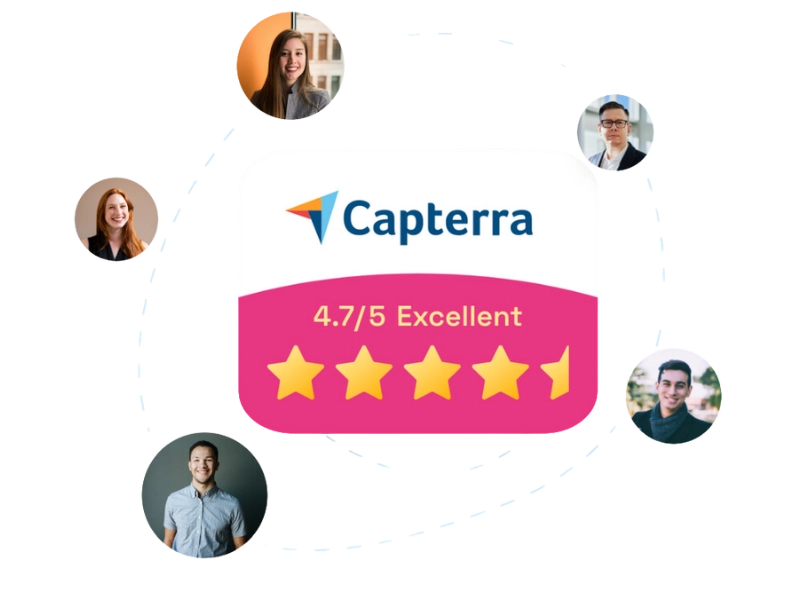SharePoint App Development: Our Introductory Guide
Developing applications for SharePoint is currently in a phase that balances customization with low-code approaches.
All companies are looking for flexible, scalable, and interconnected solutions, focusing on automating internal processes and improving the user experience. Modern SharePoint applications have therefore evolved from being simple add-ons to becoming hubs that simplify collaboration and business data management.
In this article, we will explore the best practices for developing applications on SharePoint using tools such as SPFx and Power Platform. We will also look at some practical examples to understand how these solutions can be implemented within a company.
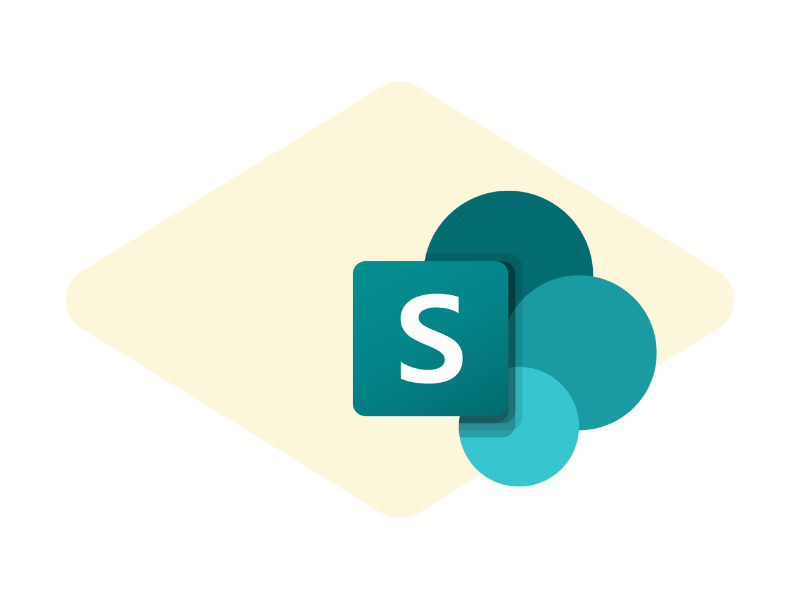
SharePoint app development: how to get started
Developing applications for SharePoint today revolves around a vision that is strongly focused on creating responsive, modular, and easy-to-maintain solutions.
This evolution is made possible by new frameworks and methodologies that, on one hand, allow rapid prototyping and the involvement of professionals without a strictly technical background, and on the other hand, enable professional developers to go well beyond out-of-the-box functionalities, creating applications that are deeply integrated with the rest of the Microsoft 365 ecosystem.
Among these tools, the SharePoint Framework remains the main reference point on which developers base their work.
SPFx stands out for its ability to offer a structure based on components and web libraries, which can be used with modern front-end technologies such as React or Angular. Thanks to support for TypeScript, Node.js, and Gulp/Webpack, it allows the creation of ready-to-use, scalable, and secure solutions.
Moreover, the presence of a standardized packaging and distribution model speeds up release times, simplifying the deployment phase on SharePoint Online tenants or hybrid environments.
On the deployment side, building custom solutions with SPFx allows for the distribution of packages containing web parts, extensions, and static assets. These packages are uploaded to the SharePoint App Catalog, enabling controlled publishing. A farm administrator (on-premises) or tenant administrator (online) can decide which solutions to authorize and in which sites to enable them.
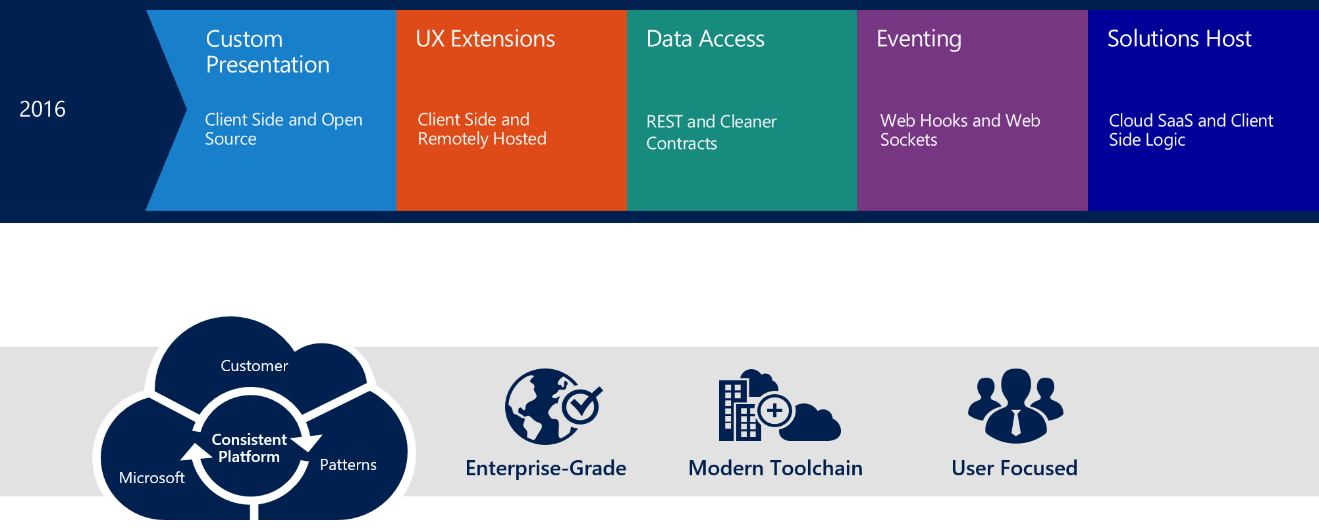
Modern structure of the SharePoint Framework
One of the most interesting aspects of the current landscape is the coexistence of low-code/no-code tools and traditional development systems, which exist side by side to meet different needs, as shown in the following table.
| Development approaches in SharePoint | Description |
| Low-code / No-code | Consider users without programming skills who need to build applications to optimize their company’s processes. Thanks to platforms like Power Apps, it is possible to create forms and interfaces that rely on SharePoint lists or libraries, natively integrating with modern pages and the workflows defined in Power Automate. This enables rapid prototyping using ready-to-use templates and connectors. |
| Custom development | At the same time, companies with more complex requirements rely on expert developers who work with SPFx or other extensibility models such as add-ins. In these cases, it is possible to build tailored components where the business logic extends far beyond simple forms. Think, for example, of a service portal integrated with an external ERP, where data from the ERP flows into SharePoint and is processed by custom components showing analytics, interactive charts, and semantic search engines. |
This duality between low-code/no-code and traditional development promotes a collaborative model within IT teams. Business-oriented professionals define processes and data structures, while developers create more sophisticated functional blocks to be reused as components.
These components can also be used by "citizen developers", meaning corporate professionals who do not have a full programming background but possess strong knowledge of internal processes and SharePoint.
Another key factor in building SharePoint applications is the increasing integration with Microsoft 365 and new AI-based technologies.
Let’s take a closer look in this table.
| Integration area | Features and benefits for SharePoint apps |
| Microsoft Teams | SharePoint solutions can be exposed directly in Teams as tabs, bots, or custom apps. Using the SharePoint Framework and the Teams Toolkit for Visual Studio Code, developers can build SharePoint apps that use Teams components such as Adaptive Cards, interactive chats, and automated notifications without forcing users to switch contexts. With the introduction of Copilot in Teams, SharePoint apps can also integrate AI capabilities to provide suggestions, query document databases, and trigger automated actions based on user behavior. |
| Microsoft 365 | SharePoint apps can access real-time data from other Microsoft 365 services to provide a richer experience. Through Microsoft Graph APIs, developers can connect their SharePoint apps to Outlook, OneDrive, Planner, and even Loop, enabling content co-creation and task management directly within the app interface. Integration with Forms Premium and Viva Engage also allows SharePoint apps to include interactive forms, feedback collection, and personalized communications. |
| AI and automation tools | SharePoint application development can leverage Copilot to suggest content and metadata. In addition, Power Automate and Power Virtual Agents allow developers to enhance their apps with advanced workflows and chatbots that interact directly with SharePoint document repositories. |
Thanks to these varied development approaches, SharePoint apps are no longer limited to traditional document portals. They now include interactive apps with AI components, dynamic dashboards, and collaboration tools fully integrated with Microsoft 365.
SharePoint’s role as a digital hub is further strengthened by the adoption of modern front-end technologies, the use of Fluent UI for a more intuitive interface, and a mobile-first approach that ensures responsive experiences on any device.
Sustainability of solutions also plays a central role.
Developers adopt reusable components, micro front-end architectures, and shared standards to minimize redundancy. Tools like npm, which are not just an online archive but a complete package manager for JavaScript and TypeScript environments, simplify solution updates without requiring the entire app to be recompiled.
Let’s go into more detail:
| Strategy for SharePoint app development | Description |
| Reusable components | Developers avoid writing custom code for each need by following a modular approach with shared components. Web parts and forms can be reused across multiple SharePoint sites without being rewritten, making UX consistent and reducing update time. |
| Micro front-end and modular architecture | SharePoint apps are built with a distributed architecture that splits the interface into independent microcomponents. Rather than building a monolithic app, each interface part (navigation bar, filters, charts, interactive forms) is standalone and can be updated separately without affecting the whole system. This model, inspired by back-end microservices, improves scalability and allows for faster, targeted updates. |
| Code management with npm and shared repositories | To support component reuse and distribution, developers use centralized repositories like npm (Node Package Manager). This enables publishing, managing, and updating internal libraries without manually editing each app that uses them: a crucial method for large organizations where different teams work on multiple SharePoint projects but share the same structural components. |
Lastly, there are considerations related to migration.
Many companies using on-premise solutions are shifting to SharePoint Online to reduce infrastructure management and take advantage of cloud-only features such as dynamic web parts for communication sites, Microsoft Teams extensions, and Copilot integration.
In these cases, the app development approach often changes. Some farm solutions are reimplemented using SPFx, while classic add-in model apps are revised to leverage cloud identity mechanisms.
Developers specializing in SharePoint applications must therefore plan the transition, identify compatibility gaps, and redesign workflows or legacy service dependencies where needed.
SharePoint app development: how it changes when Power Platform is integrated
The integration between SharePoint and Microsoft Power Platform represents one of the most important advancements in building modern business solutions. By combining SharePoint’s native capabilities with tools like Power Apps, Power Automate, and Power BI, it becomes possible to create fully automated applications and processes tailored to the specific needs of an organization and its workforce.
This creates a strong synergy, resulting in a unified environment where data, interfaces, workflows, and reports come together, offering teams a single platform to collaborate and manage their activities.
Let us start with a quick overview of the integration with Power Apps, which allows you to extend and customize the SharePoint experience without having to write complex code. Thanks to a low-code system, all users can build dynamic forms and custom interfaces that rely on SharePoint lists or document libraries.
As a result, it is possible to design a form for vacation requests or IT issue reporting, for example, where the entered data is automatically stored in a SharePoint list. At the same time, the buttons and controls within the app can be configured to trigger predefined actions or to show specific fields only under certain conditions.
These forms replace the basic native SharePoint forms.
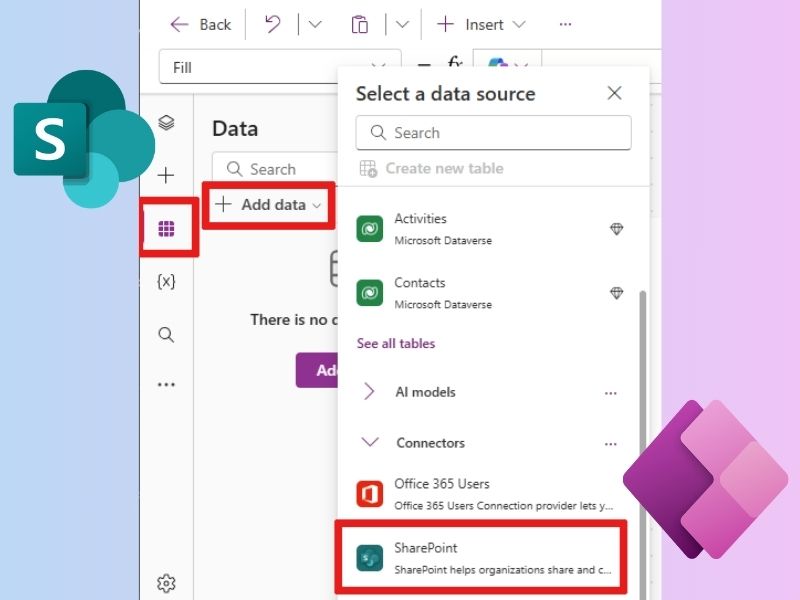
Connecting a Power Apps application with a SharePoint site
Next, we have Power Automate, which is playing an increasingly important role in developing applications for SharePoint, thanks to its new intelligent features for automating and orchestrating business processes.
In addition to traditional management of automated workflows, Power Automate now integrates Copilot AI to assist developers in creating flows by suggesting actions and configurations based on their requests. The graphical interface of Power Automate, enhanced with AI prompts and assisted configuration, also allows for the rapid development and testing of complex flows without the need for advanced scripting.
SharePoint app developers can orchestrate hybrid workflows, where Power Automate interacts with Power Apps and Power BI, making it easier to move from a customized user interface to process automation and data visualization.
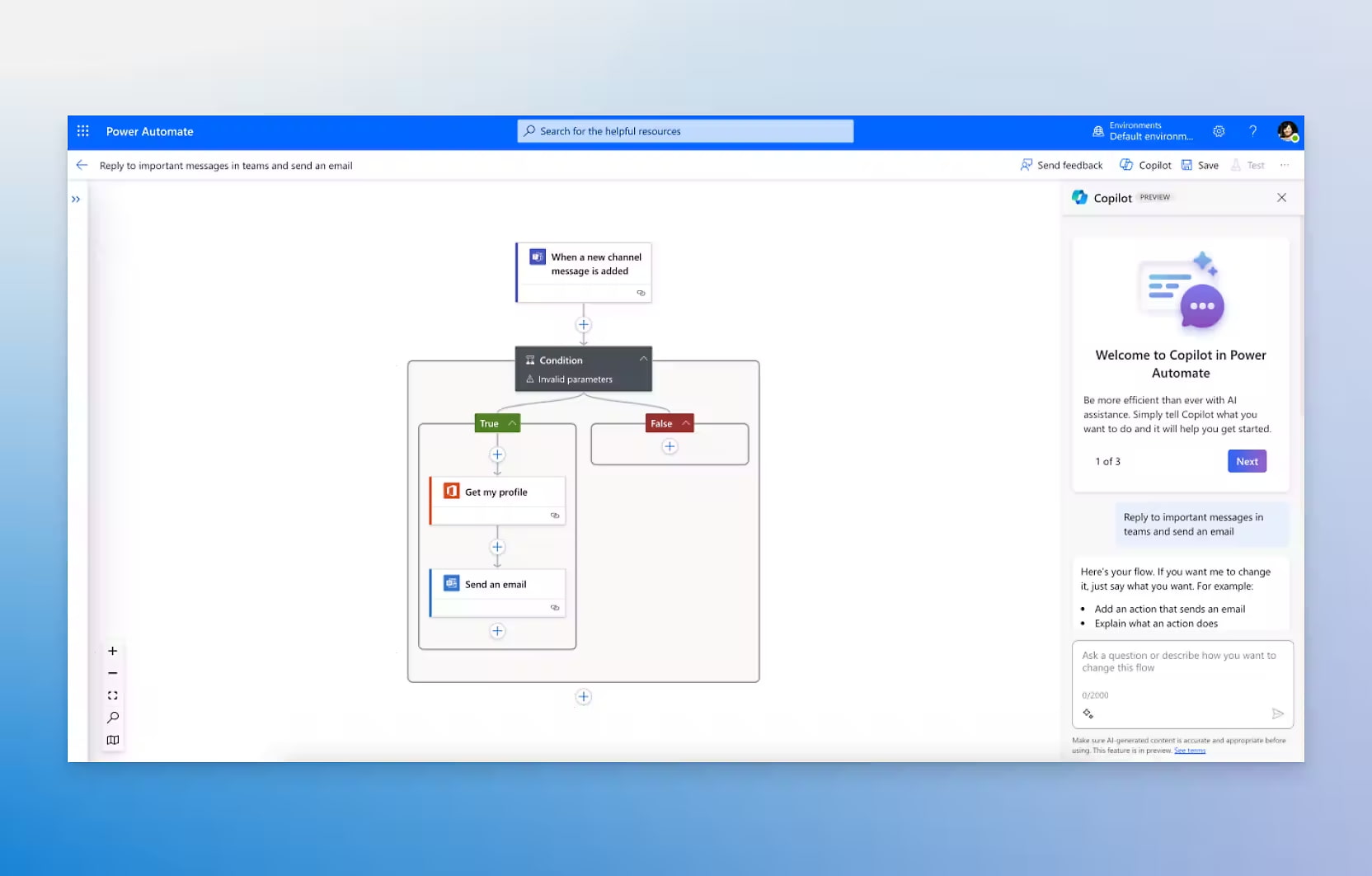
Overview of Copilot integration in Power Automate
The analytical component of the integration between SharePoint and the Power Platform is handled by Power BI, Microsoft's business intelligence tool that enables the creation of interactive reports and dashboards. With Power BI, SharePoint becomes a platform for advanced analytics and interactive reporting, also thanks to its increased integration with Copilot.
For SharePoint app developers, Power BI makes it possible to analyze in real time the data extracted from document libraries, custom lists, and workflows, embed interactive dashboards directly into modern SharePoint pages, and create automated reports that also include AI-generated insights.
Finally, the introduction of Power BI Embedded enhances the customization of SharePoint apps by allowing tailored reports and real-time data interactions to be integrated. It is therefore not necessary to access Power BI separately to view company reports.
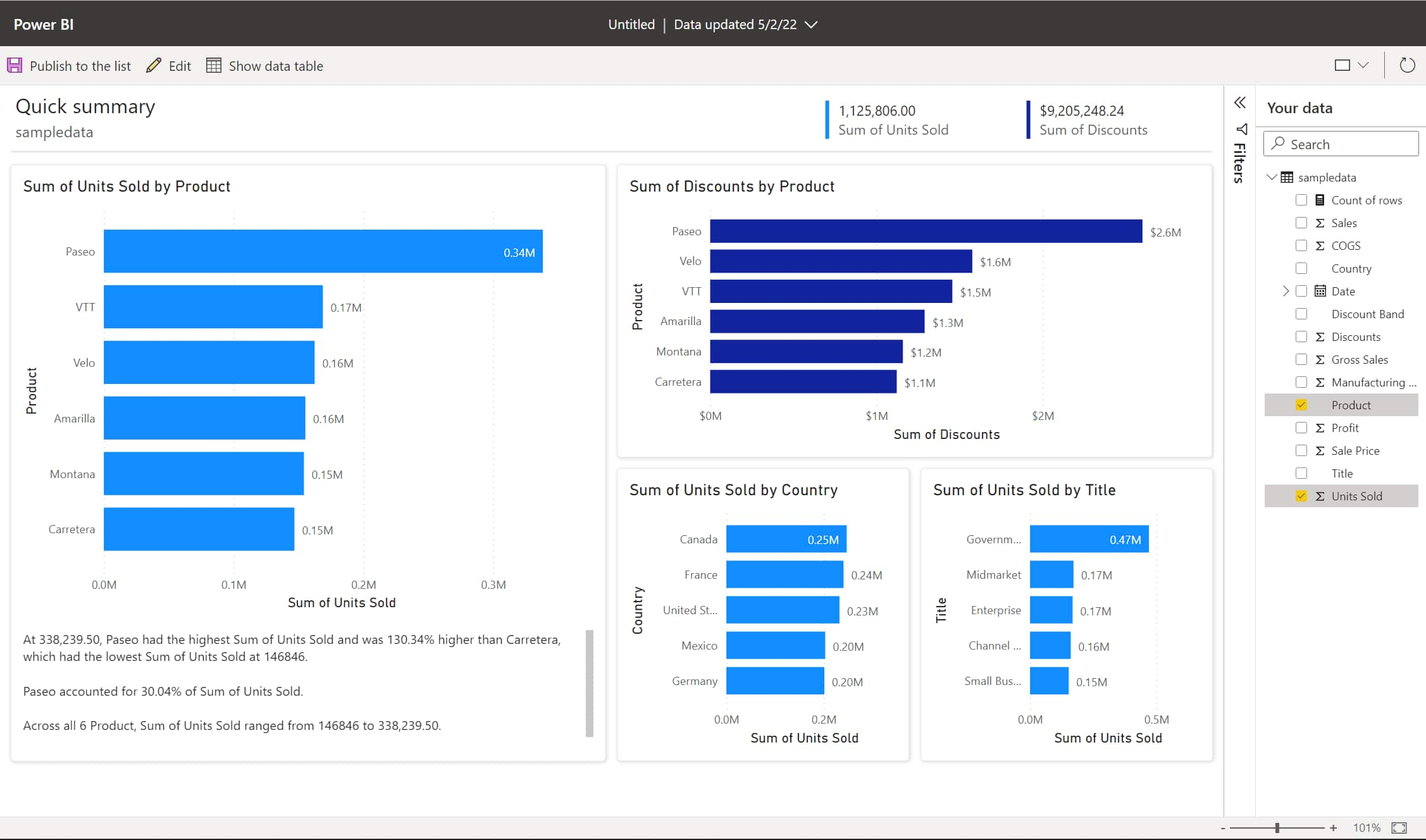
Quick data visualization in SharePoint through Power BI reports
An interesting aspect of integrating the Power Platform with SharePoint lies in the ability to orchestrate solutions that involve multiple modules of the platform in a single experience. A clear example is the creation of an application with Power Apps that, in addition to saving and reading data from SharePoint, triggers a Power Automate flow to validate and process that data, and finally sends the results to Power BI for more detailed analysis.
End users interact with a single front-end tool, while behind the scenes, the Power Platform coordinates various services that communicate and share information without any manual intervention.
The use of connectors and APIs is also extremely useful to support these integrations. When a company uses management systems or external services, Power Automate and Power Apps connectors provide an easy way to integrate SharePoint with those environments without needing to write dedicated code.
If a connector already exists (for example, for Salesforce, SAP, Azure DevOps, or Gmail), the configuration only requires setting up the credentials and essential parameters. In the case of custom applications, it is possible to use generic connectors based on REST or standard protocols.
From the user's perspective, integration with the Power Platform enables the creation of much more sophisticated interfaces and processes compared to the native features of SharePoint.
A user might browse a modern page through an embedded Power Apps web part, fill out an interactive form, and trigger a workflow that logs the data in SharePoint and, at the same time, generates a ticket in an IT management system.
On the other hand, a manager can use Power BI to monitor the queue of open tickets and their distribution by category, in order to identify where the main bottlenecks are. All of this happens without the need to constantly switch between different platforms, since navigation always remains centralized in SharePoint.
SharePoint PnP: best practices and development standards
When talking about modern application development on SharePoint, we cannot fail to mention the SharePoint Patterns and Practices project, an initiative supported by Microsoft and contributions from developers around the world.
PnP provides code samples, guidelines, scripts, and tools to automate and standardize the creation of custom SharePoint solutions. Through open-source repositories, developers can find inspiration to build applications already recognized as best practices, reducing the likelihood of introducing security vulnerabilities or ending up with non-scalable platforms that are therefore unsuitable for supporting internal process digitalization (which would cause the company to waste its investment in both development and adoption).
Within the wide range available, there are PnP templates and snippets that show how to:
- integrate an external authentication service;
- develop a web part that consumes a Power Automate API;
- build a custom navigation extension compatible with modern sites.

SPFx web part with PnP "Details List" layout
One of the most appreciated aspects of this initiative lies in the PnP repositories, which are online archives offering scripts, sample code, and open-source libraries.
Developers can find reusable snippets for SPFx web parts, automated deployment procedures, and provisioning templates (although the offering is much broader).
This variety of resources helps reduce development time and costs, as it allows teams to draw on solutions already tested by a wide community of professionals. Moreover, adopting PnP samples and the recommendations provided in the official documentation is a great strategy for writing code that better aligns with Microsoft’s guidelines, resulting in clear benefits in terms of reliability and data security.
A key focus of the PnP community is the sharing of best practices on various topics, from information architecture to workflow definition, from designing responsive web parts to packaging solutions ready for deployment.
The guidelines do not just explain how to write "working" code, but also show how to create solutions that can be properly maintained and scaled for a large number of users.
For SharePoint developers, this means having access to a consolidated body of knowledge.
PnP solutions, in fact, emerge from real-world challenges and are enriched over time as the community experiments or responds to issues shared by peers.
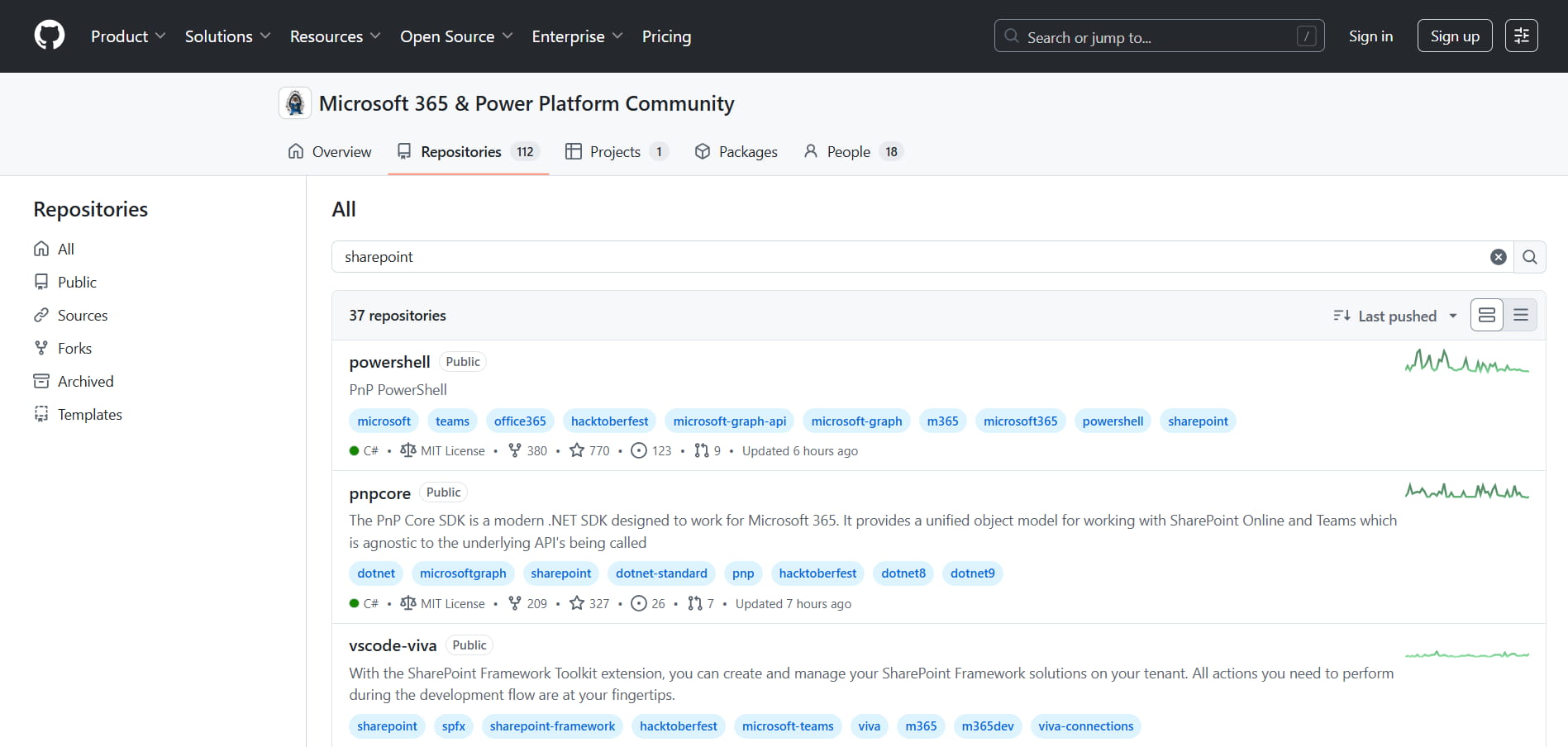
PnP repositories hosted on GitHub
Within PnP, one of the tools that draws the most attention is PnP PowerShell, a module that offers over 700 cmdlets for managing administrative and development tasks in Microsoft 365 environments, including SharePoint Online and Microsoft Teams.
Using PnP PowerShell simplifies tasks that would otherwise require custom scripts or even manual interventions. For example, these resources allow teams to manage the creation and configuration of site collections, permission assignments, provisioning of SPFx components, or content migration between environments. For IT teams, this means gaining more precise control over their tenants, with the ability to automate tasks and quickly scale management for large-scale projects.
However, the PnP community does more than provide scripts and snippets.
One of its core principles is the continuous exchange of knowledge among developers, consultants, and IT professionals. The PnP GitHub repositories host discussion forums and areas for reporting issues or feature requests, where users can seek support, suggest improvements, or propose new features.
Thanks to these channels, even complex problems can find shared solutions, further enriching the resource archive. Often, Microsoft itself draws on these suggestions to update its platforms.
The adoption of PnP also has a positive impact on data security within organizations.
When an organization standardizes its development and deployment processes based on the patterns suggested by the community, it gains a more uniform set of solutions, where each web part, extension, and connector follows the same architectural logic.
Moreover, provisioning templates allow teams to recreate preconfigured SharePoint environments with lists, libraries, pages, and permissions, speeding up the onboarding of new projects or the cloning of sites for specific activities (such as department-specific vertical sites, external collaboration spaces, internal training portals, and so on).
PnP solutions also aim to maintain a high standard of performance, which is essential when SharePoint is used by thousands of users simultaneously or handles large volumes of data.
The proposed patterns include best practices for minimizing server requests, optimizing queries, and making the best use of client-side APIs. The same optimization principles apply to REST calls, static resource loading, and list structures, promoting a design that balances flexibility and performance.
If the number of users increases, or if digital transformation projects require new sites, flows, and integrations, PnP practices and samples help replicate successful models in an organized way. Consider a company launching an intranet with specific content for each regional branch while maintaining a set of common features (such as a standard layout, a web part package, and a minimum permission level).
Without automated procedures based on PnP, configuring each site could become a manual task and therefore more prone to errors. This risk can be avoided by applying the correct templates and scripts, which reduce variance, ensure more predictable timelines, and minimize inconsistencies across environments.
PnP also has strong educational value for aspiring developers.
Those approaching SPFx or automation models with PnP PowerShell will find complete and well-explained examples, designed to provide a reliable starting point for understanding provisioning, packaging, or updating mechanisms. This is especially relevant for IT departments looking to train new staff or consultants who need to quickly align with ongoing project standards.
Many companies already choose to include exercises based on the PnP repositories in their internal training, so that their technicians can immediately learn Microsoft-recommended practices.
SharePoint app development: some practical examples
To better explain what has been illustrated so far, we want to conclude our brief guide with a series of practical examples related to SharePoint app development, which can serve as inspiration to improve productivity within your organization.
| SharePoint app example | Technologies used | Functionality |
| Document management portal with automated approval |
|
The goal is to centralize document management and reduce review times. We develop an app that allows uploading contracts to a SharePoint library, with a custom web part that shows approval status. Power Automate integration enables automatic notifications to reviewers, assigning approvals based on manager-defined rules, and updating the document status in real time. |
| Personnel management dashboard |
|
To monitor vacations, absences, and colleague requests, we can create a Power Apps app capable of reading and writing data in a SharePoint list through an intuitive interface. A Power BI dashboard displays leave metrics, highlighting critical periods for each department. Automatic notifications via Teams inform managers when a leave request requires approval. |
| Custom intranet with dynamic company news |
|
To create an intranet with targeted content, we develop a custom SPFx web part that displays news filtered by department and user location. Integration with Microsoft Graph API retrieves events from Teams and recent documents related to the user's work. The app can also be included in Viva Connections, allowing colleagues to access news from Teams. |
| Project management portal with interactive board |
|
If a team wants a Kanban board to manage its projects without using external software, a valid solution is an SPFx web part with drag-and-drop interface to organize activities. Task data is stored in SharePoint lists, with access rules based on user roles. A Power Automate workflow sends automatic updates via Teams when a task changes status or is assigned to a new user. |
| Equipment request catalog |
|
To simplify the management of company device requests, we can create a Power Apps app connected to a SharePoint list that contains the available inventory. Employees can select the desired equipment and submit a request. Power Automate then generates a ticket, updates availability, and sends a notification to managers for approval. |
These examples show how SharePoint can be used flexibly to create tailored solutions that meet the specific needs of your business. Whether managing documents, organizing projects, or simplifying HR workflows, the platform helps digitize all internal processes, with a positive impact on people's daily work.
Beyond individual applications, it is important to note that the use cases presented (and many more) can be centralized and harmonized within a single solution: the intranet.
Not by chance, this platform is increasingly chosen by companies of any size and sector as the foundation of their digital workplace. Adopting a SharePoint-based intranet makes it possible to gather all necessary resources and features in one environment, without wasting time searching for the right app for each task.
Thanks to a complete, ready-to-use yet highly customizable solution like the one developed by the intranet.ai team, the time and costs required for any custom or low-code development are drastically reduced.
Do you want a complete, ready-to-use intranet?
intranet.ai is the SharePoint Online-based solution for simplifying internal communication and digitizing business processes with minimal investment of time and money.
- 50+ features for communication and employee experience
- Branded design, customizable in every detail
- Full integration with Microsoft 365 and Viva
Giuseppe Marchi
Microsoft MVP for SharePoint and Microsoft 365 since 2010.
Giuseppe is the founder of intranet.ai and one of the top experts in Italy for all things Microsoft 365. For years, he has been helping companies build their digital workspace on Microsoft's cloud, curating the people experience.
He organizes monthly online events to update customers on what's new in Microsoft 365 and help them get the most out of their digital workplace.

FAQ on SharePoint app development
What is the role of the SharePoint Framework in SharePoint app development?
SPFx is the main framework for creating modern applications on SharePoint. It allows the development of modular web parts and extensions using React, TypeScript, and tools like Webpack, ensuring scalability, security, and centralized deployment through the App Catalog.
What approaches are available for developing applications on SharePoint?
You can adopt a low-code or no-code approach using Power Apps and Power Automate, ideal for rapid prototyping and business users, or choose custom development with SPFx, suitable for complex and highly customized scenarios.
How does the Power Platform integrate into SharePoint app development?
Power Apps allows the creation of dynamic interfaces, Power Automate automates workflows, and Power BI enables the integration of dashboards and reports. These tools natively interact with SharePoint to build complete and automated experiences.
What does SharePoint PnP offer for developers?
The SharePoint PnP project provides reusable code, scripts, templates, and over 700 PowerShell cmdlets to standardize and accelerate development. It helps maintain consistency, security, and high performance in SharePoint environments.
What strategies make SharePoint app development sustainable?
The adoption of reusable components, modular architectures based on micro front ends, and shared repositories like npm makes it easy to update and maintain applications, reducing redundancy and maintenance costs.
How should a migration from SharePoint on-prem to SharePoint Online be handled?
The migration involves converting farm or add-in solutions to SPFx, reviewing legacy workflows, and adopting cloud authentication models. It is essential to design the transition with compatibility and online-only features in mind.
What are some examples of business apps you can build using SharePoint?
Examples include document portals with automated approvals, HR dashboards with Power BI, interactive Kanban boards, equipment request catalogs, and customized intranets with dynamic content.
What is the difference between a SharePoint intranet and a custom application?
An intranet centralizes communication, document management, HR tools, and collaboration in a single environment. A custom app is focused on a specific function. The intranet offers consistency and governance, while the custom app provides tailored flexibility.
When is it better to develop an app on SharePoint rather than adopt an intranet?
It is better to develop an app when there is a specific need or when you want to validate a process. An intranet is more suitable when you want to unify tools and communication in a single structured digital environment.
What does intranet.ai offer compared to custom development?
intranet.ai is a ready-to-use solution integrated with SharePoint Online that includes over 50 applications (document management, notifications, org chart, profiles, FAQs, etc.). It reduces time and costs compared to building from scratch, while allowing customization.
Can custom apps be integrated into a SharePoint intranet?
Yes, it is possible to extend an intranet with SPFx web parts, Power Apps, and Power Automate flows, while maintaining a consistent and integrated experience for the end user.
Keep on reading
Best Practices for Creating an Efficient Structure in SharePoint



Our experts' tips to optimize the structure of SharePoint and improve governance, collaboration, and document management.
SharePoint Intranet Tips, for Beginners and Experts



Our consultants' advice on how to design a good SharePoint intranet, manage it properly, and help it grow by engaging your colleagues.
SharePoint vs Confluence: Which One to Choose?



Let's compare Microsoft SharePoint and Confluence to understand which platform is best for your company and how to manage the migration process.
